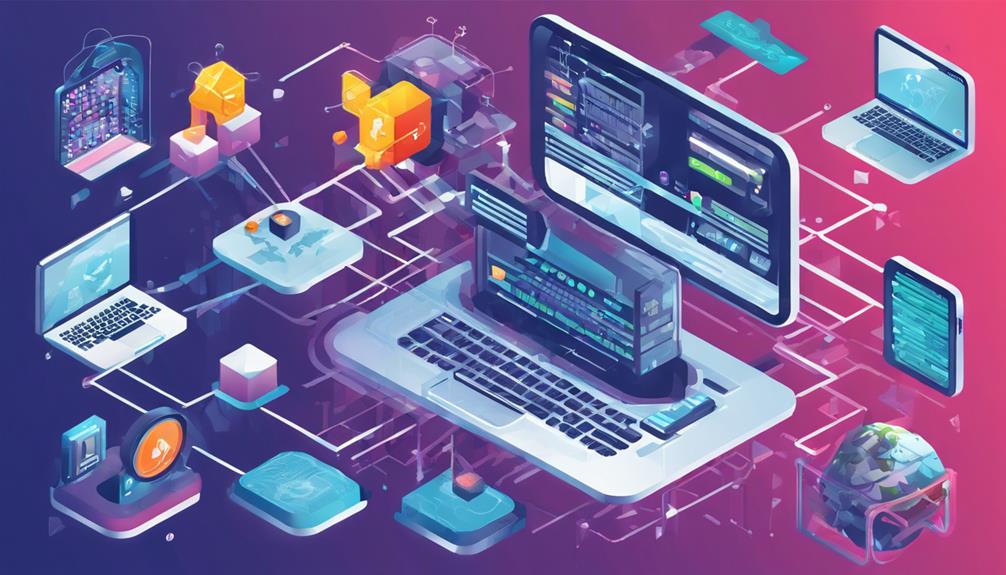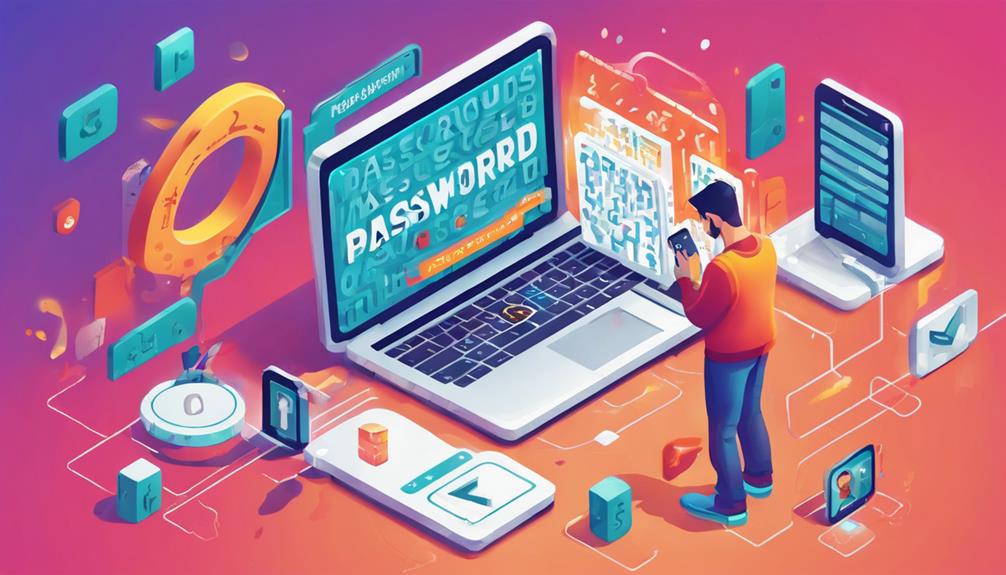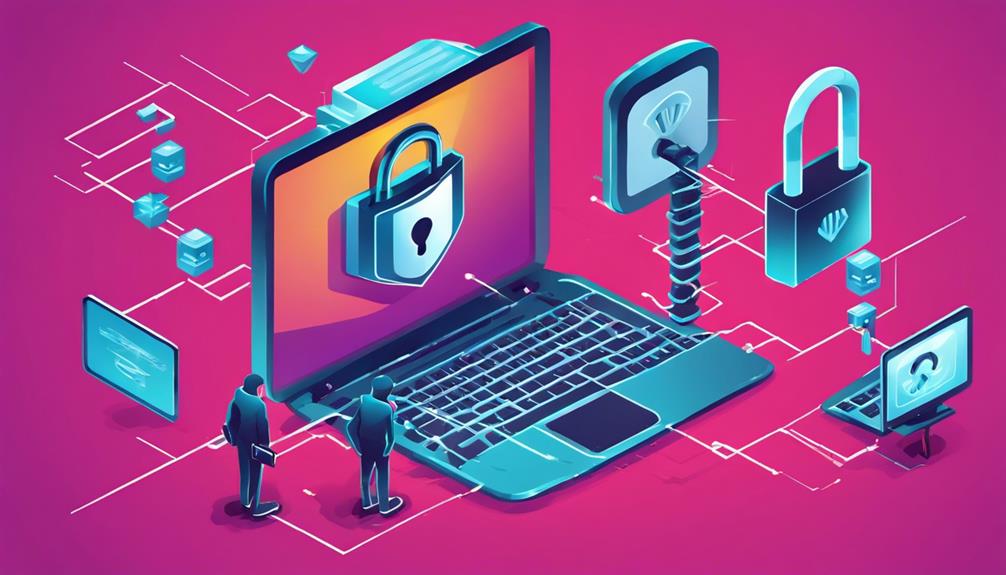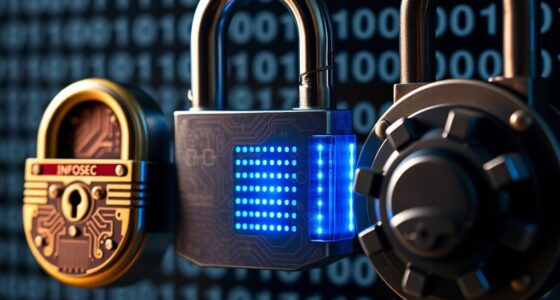Enhance online security with 10 key measures: Use strong, unique passwords with a mix of characters. Implement Two-Factor Authentication for extra security layers. Beware of phishing scams and suspicious links. Optimize DNS servers for faster, safer browsing. Secure Wi-Fi networks, update router firmware, and encrypt data. Stay current with cybersecurity; update software regularly. Protect your IP address and use device security measures. Remember, secure networks, backup data, and keep systems up-to-date are paramount. These tricks can deter hackers effectively and safeguard your sensitive information.
Key Takeaways
- Use strong, unique passwords with a mix of characters.
- Enable Two-Factor Authentication for added security.
- Avoid clicking on suspicious links to prevent phishing attacks.
- Optimize DNS security with reputable DNS servers.
- Regularly update software and devices for enhanced protection.
Strong Passwords
To guarantee robust protection of your online accounts, it is imperative to create and maintain strong passwords. Strong passwords should be at least 12 characters long, incorporating a mix of uppercase and lowercase letters, numbers, and symbols to increase their resilience against hacking attempts. Avoid using easily guessable information like birthdays or pet names, as these make passwords vulnerable to being cracked. Changing passwords regularly is also essential to prevent unauthorized access to your accounts.
One effective way to manage multiple complex passwords securely is by utilizing a password manager. A password manager is a tool that securely stores and generates strong, unique passwords for each of your online accounts.
Two-Factor Authentication

Two-factor authentication, commonly referred to as 2FA, is a security measure that adds an extra layer of protection to online accounts. It works by requiring users to provide a secondary form of verification, such as a code from a mobile app, in addition to their password.
Setting up 2FA can help enhance security by greatly reducing the risk of unauthorized access to personal information and accounts.
How It Works
By requiring an additional form of verification alongside passwords, two-factor authentication greatly enhances online security. This method adds an extra layer of protection by necessitating a secondary form of verification beyond just a password.
One popular tool for implementing this security feature is the Google Authenticator app, which generates time-based, one-time passcodes for 2FA. Two-factor authentication is highly effective in preventing unauthorized access to online accounts, even if a password is compromised.
By implementing 2FA, individuals can markedly reduce the risk of unauthorized logins and protect sensitive information from falling into the wrong hands. This enhanced security measure makes it more challenging for hackers to gain access to accounts, even if they manage to obtain login credentials through various means.
Setting It up
Enhancing your online security through the implementation of two-factor authentication involves setting up an additional layer of verification beyond passwords. Security experts recommend the following steps to effectively set up two-factor authentication:
- Choose a reputable 2FA app like Google Authenticator to generate unique verification codes.
- Link your online accounts to the chosen 2FA app by following the setup instructions provided.
- Enable 2FA for all applicable accounts, including email, social media, and financial platforms.
- Store backup codes securely in case you lose access to the 2FA app or device.
- Regularly review and update your 2FA settings to ensure maximum security measures are in place.
Benefits and Risks
Implementing two-factor authentication offers users notable advantages in enhancing online security while also introducing potential risks to take into account. Two-factor authentication (2FA) adds an extra layer of security by requiring users to provide a second form of verification beyond just a password.
The Google Authenticator app is a popular choice for generating 2FA codes that expire after a short period, enhancing security. This method is effective in preventing unauthorized access even if a hacker manages to obtain a user's password through phishing or other means.
By implementing 2FA, the risk of unauthorized access to online accounts and sensitive information can be considerably reduced. Two-factor authentication is a widely recommended security measure to protect against account takeovers and data breaches.
However, challenges such as potential technical issues, device compatibility concerns, and the risk of losing access if the second factor is unavailable should also be considered when opting for this security measure.
Beware of Phishing

A critical aspect of online security involves being vigilant against phishing attempts, a prevalent method used by cybercriminals to deceive individuals into divulging sensitive information. Phishing is a common cyber attack method where hackers impersonate legitimate entities through emails, text messages, or fake websites to trick individuals into revealing personal data like passwords or financial details.
- Avoid clicking on suspicious links: Hover over links to verify their destination before clicking.
- Verify the legitimacy of websites: Look for secure website indicators like HTTPS and padlock icons.
- Be cautious of unsolicited requests for personal information: Legitimate organizations rarely ask for sensitive data via email.
- Use tools like virustotal.com: Verify links and scan files for potential threats before interacting with them.
- Practice user awareness and skepticism: Question unsolicited communications and verify online requests to prevent data breaches and identity theft.
Optimize DNS Servers

Optimizing DNS servers is an essential step in fortifying your online security and enhancing network performance. Default DNS servers provided by Internet Service Providers (ISPs) may lack in both performance and security, potentially exposing vulnerabilities in your network.
By switching to higher-performing DNS servers like Google or Cloudflare, you can greatly enhance internet browsing speed and improve privacy protection. Efficient translation of domain names to IP addresses is vital for smooth and secure internet access, making optimized DNS servers a key component in ensuring seamless online experiences.
Enhancing the security of DNS servers is paramount to reducing the risk of DNS-related attacks and strengthening overall network security. Choosing the right DNS server can be a simple yet powerful method to fortify your online security defenses and safeguard your data from potential threats.
Therefore, investing time and effort in optimizing DNS servers can yield substantial benefits in terms of both performance and security for your online activities.
Network Security Enhancements

Network security enhancements are essential for safeguarding personal information and preventing cyber threats. Measures such as securing Wi-Fi networks, implementing firewall protection, and regularly updating security software can greatly strengthen your online defenses.
Secure Wi-Fi Networks
How can you bolster the security of your Wi-Fi network to safeguard against potential cyber threats?
To secure your Wi-Fi network effectively, consider implementing the following measures:
- Change the default administrator password: Cyber attackers often target default passwords, so changing it can prevent unauthorized access.
- Enable WPA2 or WPA3 encryption: This guarantees that data transmitted over your Wi-Fi network is protected from interception by malicious individuals.
- Disable SSID broadcasting: By making your network invisible to casual users and hackers, you reduce the risk of unauthorized access.
- Implement MAC address filtering: This allows you to specify which devices can connect to your Wi-Fi network, enhancing control and security.
- Regularly update your router's firmware: Keeping your router's software up to date is essential in patching security vulnerabilities and maintaining top-notch network security.
Implement Firewall Protection
Enhancing network security through the implementation of robust firewall protection is paramount in safeguarding against cyber threats and unauthorized access. Firewalls serve as an important barrier between your network and potential malicious software, monitoring and controlling incoming and outgoing traffic.
They can be hardware-based, such as physical devices, or software-based, like programs installed on a device. Firewalls play a critical role in preventing unauthorized access, blocking malicious traffic, and filtering out potentially harmful data that could compromise sensitive information.
Update Security Software
Consistently updating security software is essential for maintaining robust network security and protecting against emerging cyber threats. By taking the time to make sure that your security software is up to date, you can greatly reduce the risk of falling victim to cyber attacks.
Here are five key reasons why updating your security software is vital:
- Regular updates help protect against evolving cyber threats.
- Outdated software can leave vulnerabilities for hackers to exploit.
- Updated security software can detect and block malicious activities effectively.
- New versions often include patches for known vulnerabilities, enhancing protection.
- Keeping software current is a proactive measure that strengthens your online security defenses.
Device Security Measures

Implementing robust security measures on your devices is essential to safeguarding your online presence and sensitive information. One vital aspect of device security is protecting your IP address, a unique identifier assigned to each device connected to a network. By securing your IP address, you can prevent unauthorized access and protect your online activities from prying eyes. Enhancing device security also involves using strong passwords, enabling two-factor authentication, and keeping your software up to date to patch vulnerabilities.
To highlight the importance of device security measures, consider the following table:
| Device Security Measures | Description | Importance |
|---|---|---|
| Protecting IP Address | Safeguarding device identity | High |
| Strong Passwords | Enhancing access security | Medium |
| Software Updates | Patching vulnerabilities | Essential |
Stay Updated on Cybersecurity

Staying updated on cybersecurity is essential in safeguarding your online presence. Regularly updating your software, enabling two-factor authentication, and using secure passwords are fundamental measures to enhance your digital security.
Update Software Regularly
Regular software updates are essential for maintaining a secure online environment and protecting against potential cyber threats.
Here are five reasons why staying updated on software is critical for your cybersecurity:
- Regularly updating software patches vulnerabilities that hackers can exploit.
- Outdated software is a common target for cyber attacks due to known security flaws.
- Updates often include security fixes to protect against newly discovered threats.
- Updating software is a proactive approach to strengthening your online security defenses.
- Neglecting software updates can leave your devices and information vulnerable to cyber threats.
Enable Two-Factor Authentication
Updating software regularly is essential for safeguarding your digital assets from cyber threats. One effective measure to bolster your online security further is by enabling Two-Factor Authentication (2FA).
Two-factor authentication adds an extra layer of security to your online accounts by requiring a secondary form of verification, such as a code sent to your phone or generated by an app like Google Authenticator. This additional step helps prevent unauthorized access, even if your password is compromised.
Cybercriminals often target accounts with weak security measures, making two-factor authentication a vital defense against their malicious activities. By regularly enabling and using 2FA, you enhance the security of your online accounts and data.
It is a simple yet powerful way to thwart potential breaches and protect your sensitive information from falling into the wrong hands. Take advantage of this security feature offered by many online platforms to fortify your digital defenses effectively.
Use Secure Passwords
Implementing robust password practices is paramount in fortifying your online security posture and safeguarding your sensitive information from potential cyber threats. Strong passwords play an important role in protecting your digital assets.
Consider the following guidelines to enhance your password security:
- Avoid Using Common Passwords: Steer clear of easily guessable passwords like '123456' or 'password.'
- Create Complex Passwords: Use a combination of letters, numbers, and special characters to make your passwords harder to crack.
- Don't Reuse Passwords: Each account should have a unique password to prevent a single breach compromising multiple accounts.
- Enable Two-Factor Authentication: Adding an extra layer of security can greatly strengthen the protection of your accounts.
- Regularly Update Passwords: Changing your passwords periodically reduces the risk of unauthorized access and potential breaches.
Secure Wi-Fi Networks

Strengthening the security of your Wi-Fi network is vital to safeguarding your online activities and sensitive information.
To secure your Wi-Fi network, start by setting a strong and unique password. Avoid using common phrases or easily guessable information like your phone number.
Enable WPA2 or the more advanced WPA3 encryption on your Wi-Fi router to add an extra layer of protection. Changing the default network name (SSID) to a unique one can also deter hackers.
Additionally, regularly updating your router's firmware is essential. These updates often include patches for security vulnerabilities, enhancing your network's defenses.
Moreover, consider creating a guest network for visitors. This separate network prevents guests from accessing your main network and helps isolate potential security risks.
Regular Software Updates

Ensuring the timely installation of software updates is essential in fortifying your digital defenses and safeguarding against potential cyber threats. Regular software updates are vital for patching security vulnerabilities and protecting against cyberattacks. Outdated software is a common target for hackers looking to exploit known vulnerabilities.
Updating operating systems, browsers, and applications helps to strengthen your defenses against online threats. Software updates often include security fixes and enhancements to keep your systems secure.
Here are some key points to bear in mind:
- Patch Vulnerabilities: Regular updates help close security loopholes that hackers may exploit.
- Stay Ahead of Threats: Security firms continually discover new vulnerabilities; updates keep you protected.
- Enhance Security: Software updates often include new security features to bolster your defenses.
- Automatic Updates: Setting up automatic updates ensures that your software is always up to date, reducing the risk of cyberattacks.
- Minimize Risks: By keeping your software current, you lower the chances of falling victim to known security threats.
Back Up Your Data

Regular software updates play an essential role in safeguarding your digital assets. Another fundamental aspect of enhancing your online security involves backing up your data regularly. By regularly backing up your data, you create a safety net against potential loss due to cyber attacks or hardware failures.
Utilizing cloud storage services such as Google Drive or Dropbox can automatically back up your files, ensuring their safety and accessibility from anywhere. Additionally, external hard drives or USB drives are effective tools for creating offline backups of your data, providing an extra layer of security.
Setting up automated backup schedules can streamline the process, ensuring that your data is always up to date and protected. In the unfortunate event of a ransomware attack, having backups of your data can prevent you from falling victim to extortion and identity theft, as you can restore your files without having to pay the ransom.
Regular data backups are an important step in fortifying your online security and safeguarding your important information.
Frequently Asked Questions
What Are 3 Things You Can Do to Avoid Being Hacked?
To avoid being hacked, implement two-factor authentication on all accounts, use a reputable password manager for strong, unique passwords, and be vigilant against phishing attempts. Regularly updating software, using a VPN on public Wi-Fi, also enhance security.
What Is the App That Protects You From Hackers?
Aura is a all-inclusive cybersecurity app offering antivirus, VPN, credit monitoring, and identity theft insurance services. It shields users from hackers by preventing doxxing and data exposure. Experience its protection with a two-week free trial.
What Websites Get Hacked the Most?
Small and medium-sized business websites, particularly e-commerce sites, are frequent targets for hackers due to the sensitive customer information they house. Content management systems like WordPress with outdated software and weak password protection are vulnerable to attacks.
What Do Hackers Want in 500 Words?
Hackers, driven by financial gain, target valuable personal information such as passwords and financial data. They exploit security vulnerabilities using tactics like phishing and malware. Understanding their motives can empower individuals to enhance online security measures.
What Is One Way Hackers Can Trick You?
Hackers can trick individuals through various methods such as phishing emails, social engineering tactics, fake websites, malicious software, and fake alerts. These deceptive techniques aim to manipulate victims into divulging sensitive information or compromising their online security.
Conclusion
To sum up, incorporating these simple tricks can greatly enhance your online security and protect your personal information from hackers. By using strong passwords, enabling two-factor authentication, staying vigilant against phishing attempts, and regularly updating your software, you can markedly reduce the risk of cyber attacks.
Remember, the safety of your online data is paramount, so take these precautions seriously. With these measures in place, you can confidently navigate the digital world with peace of mind.









